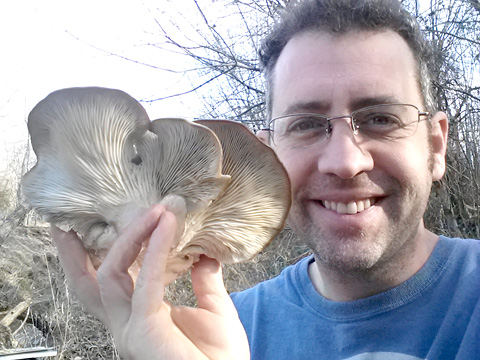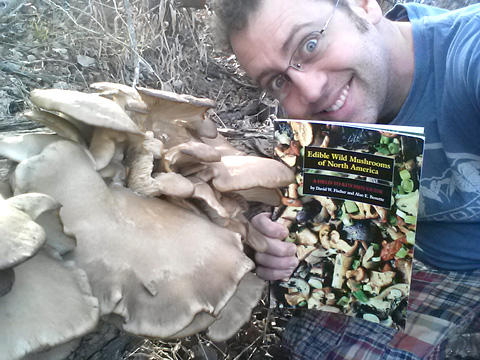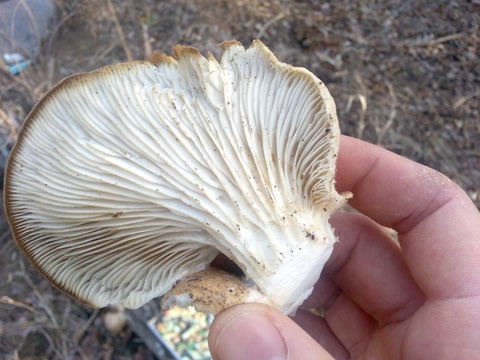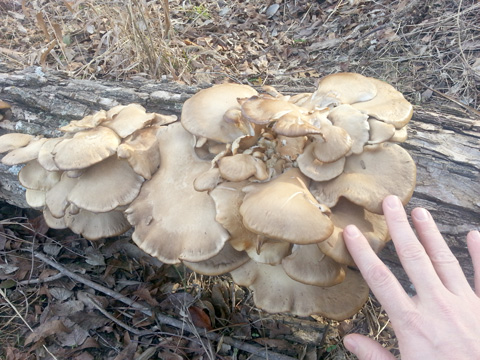I have a confession to make, and I can’t hold it in any longer:
I am a mycophage. But I’m not alone. You’re probably a mycophage, too. In fact…most of us are. If you eat mushrooms, truffles, cheese, beer, yogurt, or bread…you’re a mycophage. Mycophages eat fungus.
My house backs to a large park, the majority of which is overgrown woods. And for almost a year, I’ve been diligently searching for wild mushrooms there. And today, I was finally rewarded!
While taking Oliver for an adventure, I stumbled across a fallen log absolutely loaded down with wild oyster mushrooms.
Now before you all freak out and scream at your computer, “Don’t eat them, Ben, you’ll die!”…NO WORRIES! Oyster mushrooms are one of the easiest wild mushrooms to identify, and they have NO poisonous look-alikes. You’ve probably seen them on damp rotting logs in the forest or the park, too. They grow rampantly all over North America. And if you follow a few very simple identification steps, you can safely harvest these and eat them:
-A wild oyster has the scent of fresh shellfish…like the ocean.
-It grows ONLY on trees (fallen or upright), not in the dirt. (Unless there is a log buried just beneath the surface.)
-It can be found throughout the year, but most often in cool, wet periods from fall through spring.
-They vary in color from white to tan to gray, and the “late fall oyster” variety is caramel in color.
-The gills on the underside of the mushroom will be white, cream, or yellow (NOT orange!) The gills actually attach directly to the stem (which you can see in the photo below), and the gills will not be rough or serrated:
Best of all, the wild oyster mushroom has NO toxic look-alikes. So if you find a mushroom with all the identifying characteristics above, YOU CAN EAT IT!
This patch of wild oysters yielded 3.5 pounds when I got them back to the house. This could easily set me back $50 or more at the gourmet market, so it’s a GREAT FIND!
Wild oysters are easy and safe to forage, but many other edible mushrooms have poisonous look-alikes, so it’s important to have at least 2 solid field guides when foraging for wild mushrooms. I recommend Edible Wild Mushrooms of North America by David W. Fischer and Alan E. Bessette and The Complete Mushroom Hunter by Gary Lincoff.
Wild oyster mushrooms have a curious trait. They are carnivores! They “eat” insects. Many insects are lured to the oyster mushroom by its scent. The insects burrow into the mushroom to eat it…then the mushroom surrounds the insect with new tissue and digests nutrients from it! For this reason, mature oyster mushrooms from the wild shouldn’t be grilled or sauteed whole, because you may run into a buried beetle! To prepare wild oysters, first wash them off, then soak them in heavily salted water. Then slice them up, discarding any slices with “buried” insects in them. From this point, you can grill, saute, or cook any other way that you wish. Wild oysters tend to have a fuller flavor than cultivated oysters that you buy in the store, but are not as full flavored as most wild mushrooms like morels, chanterelles, puff balls, or maitake (Hen of the Woods).
Feel free to comment below, and subscribe to my blog for more exciting posts! (Upper right corner of this page below the header photo.)





Leave a Reply
You must be logged in to post a comment.